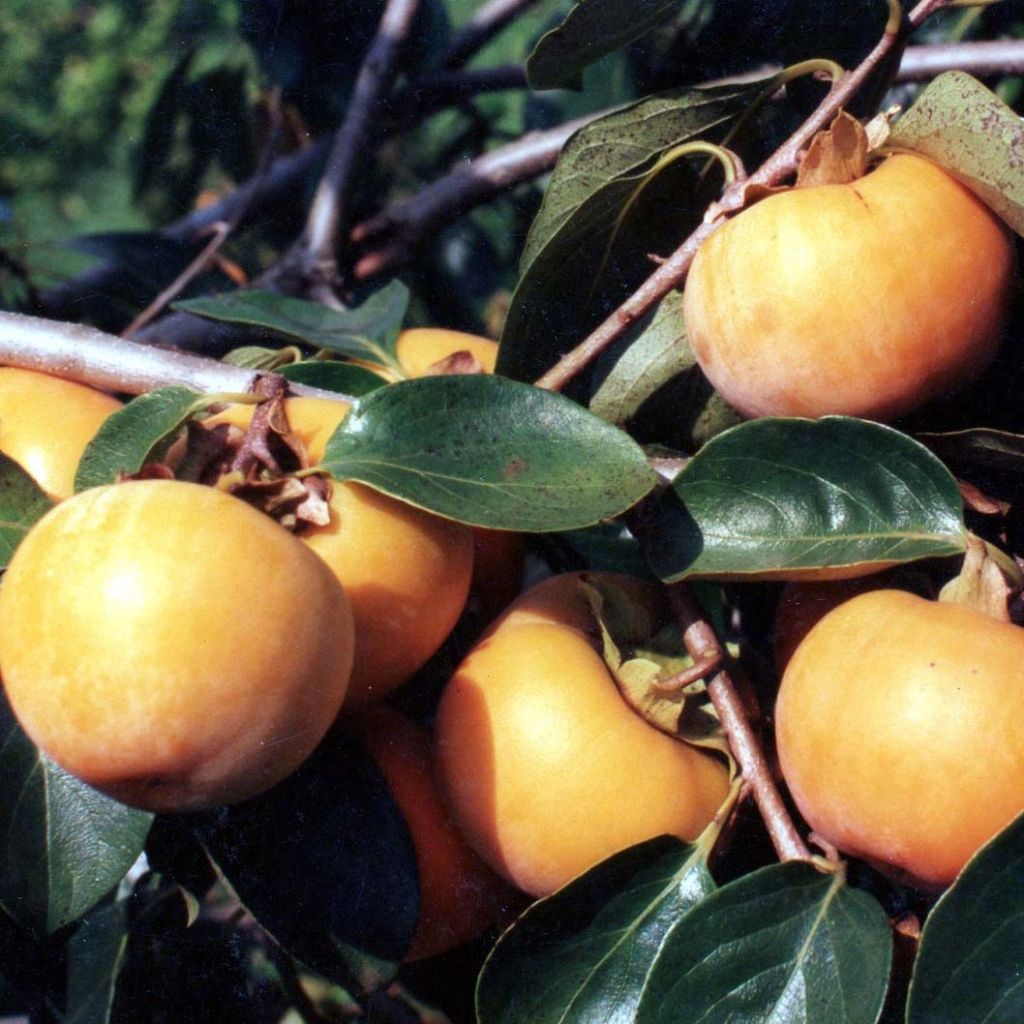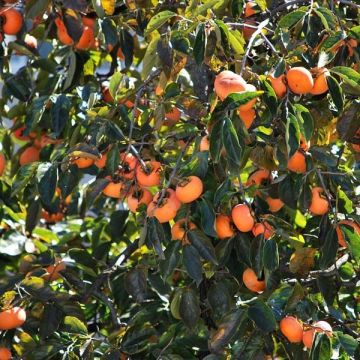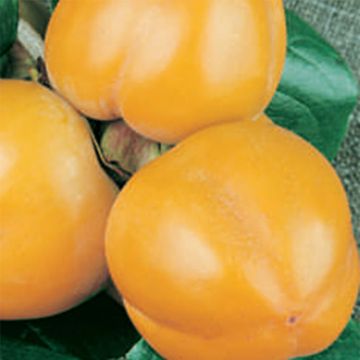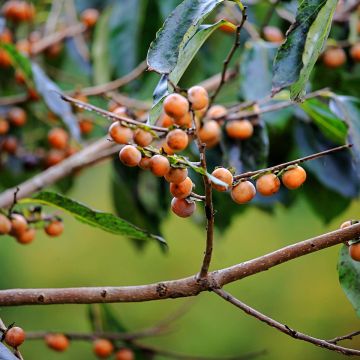

Diospyros kaki Tipo
Diospyros kaki Tipo
Diospyros kaki Tipo
Japanese Persimmon, Kaki, Asian Persimmon, Chinese date plum, Chinese persimmon, Kaki, Oriental persimmon, Persimmon, Sharon fruit
Everything is fine, the tree was very well packaged, so the delivery delay had no negative impact. I have always been very satisfied with my purchases from you.
jocelyne, 30/11/2022
This item cannot be shipped to the selected country
Oversize package delivery charge from €6.90
Oversize package delivery charge from €6.90
Delivery to Corse prohibited
More information
Schedule delivery date,
and select date in basket
This plant carries a 6 months recovery warranty
More information
We guarantee the quality of our plants for a full growing cycle, and will replace at our expense any plant that fails to recover under normal climatic and planting conditions.
Oversize package: home delivery by special carrier from €6.90 per order..
Express home delivery from €8.90.
Oversize package: home delivery by special carrier from €6.90 per order..
Express home delivery from €8.90.
Delivery to Corse prohibited: UE law prohibits the import of this plant from mainland France to Corse as part of the fight against Xylella fastidiosa. Please accept our sincere apologies.
More information
Description
Diospyros kaki Tipo is an Italian variety known for its resistance to the cold and high yield of large fruits that store well. It produces large spherical fruits that are slightly flattened and yellow in colour at harvest time, which is after the leaves have fallen. They then turn orange when they become fully-ripe. They are harvested in October-November and continue to ripen in a warm room. You can consume them when their flesh becomes soft. The tree is self-fertile, so it is not necessary to plant another Kaki nearby to obtain fruits.
The Kaki 'Tipo' produces fruit that is 8 to 10 cm (3 to 4in) in diameter, with yellow skin. Slightly flattened, they are not perfectly round. The sweet pulp is yellow-orange in colour, very juicy, and slightly fibrous, containing small seeds. Be patient: harvesting generally takes place after year 3 or year 4. Kaki fruits are not ready before the end of autumn, in October. Harvest them with secateurs. They are harvested when they are ripe, if they are soft to the touch they are fully-ripe. They should have experienced a light frost to lose their astringency. You can also try to harvest them while still firm and ripen them inside, wrapped in newspaper, near apples. For longer storage, opt for freezing. Fully-ripe harvested fruits should be consumed very quickly. In terms of cooking, Kaki can be eaten raw, cut in half and eaten with a spoon, or used in fruit salads, crumbles, jams or sometimes served with a savoury dish. It is rich in vitamin C and vitamin A.
The Kaki 'Tipo' is a moderately vigorous variety with a rather upright habit. The tree will reach approximately 6.50 m (21ft) in height and 4.50 m (15ft) in width, and its growth is quite slow. The flowering is late, appearing in June, in the form of small inconspicuous yellow flowers, which will be pollinated by insects. It is a hardy variety which tolerates exposed positions, but it requires warmth for the fruit to fully ripen.
The Kaki (Dyospiros kaki) is a tree native to China. Belonging to the ebony family, its wood is very hard. The leaves of the Persimmon tree are elongated, about fifteen centimetres long, and shiny green in colour. They take on beautiful colours in the autumn that enhance the ornamental interest of the tree. Once fallen, they reveal the fruits, which are also very decorative and remain on the branches until December. Birds love persimmons, so make sure to harvest them before they do!
Report an error about the product description
Diospyros kaki Tipo in pictures


Plant habit
Fruit
Flowering
Foliage
Botanical data
Diospyros
kaki
Tipo
Ebenaceae
Japanese Persimmon, Kaki, Asian Persimmon, Chinese date plum, Chinese persimmon, Kaki, Oriental persimmon, Persimmon, Sharon fruit
Cultivar or hybrid
Other Persimmon trees - Diospyros
Planting and care
Planting of Persimmon Tipo should be carried out in a frost-free autumn-winter period, or alternatively in spring with regular watering. Choose a very sunny and sheltered location. The Chinese Persimmon thrives in all types of soils, preferably with an acidic tendency (it dislikes too much limestone). It prefers well-drained and rich soils. This fruit tree appreciates hot and long summers. Once established, it withstands summer drought quite well (in deep soil). If you plant multiple plants, space them 5 to 7 m (16 to 23ft) apart in all directions.
Soak the root ball in water for a few moments before planting. Dig a hole 3 to 4 times the volume of the root ball, making sure to separate the lower substrate from the topsoil. Mix this substrate with bonemeal and well-rotted compost or potting compost and add this mixture into the planting hole. Add a stake and place the root ball into the planting hole without burying the collar of the plant. Cover with the topsoil and firm it in. Create a basin around the base and water generously. Attach the stake to the plant, crossing the tie in a figure of eight, without touching the trunk. Water regularly in the first year and then as needed, especially during warm periods.
Apply well-rotted compost each spring by scratching the surface around the plant, taking care not to damage the roots.
The Persimmon is not very susceptible to diseases and pests.
Planting period
Intended location
Care
-
, onOrder confirmed
Reply from on Promesse de fleurs
Haven't found what you were looking for?
Hardiness is the lowest winter temperature a plant can endure without suffering serious damage or even dying. However, hardiness is affected by location (a sheltered area, such as a patio), protection (winter cover) and soil type (hardiness is improved by well-drained soil).

Photo Sharing Terms & Conditions
In order to encourage gardeners to interact and share their experiences, Promesse de fleurs offers various media enabling content to be uploaded onto its Site - in particular via the ‘Photo sharing’ module.
The User agrees to refrain from:
- Posting any content that is illegal, prejudicial, insulting, racist, inciteful to hatred, revisionist, contrary to public decency, that infringes on privacy or on the privacy rights of third parties, in particular the publicity rights of persons and goods, intellectual property rights, or the right to privacy.
- Submitting content on behalf of a third party;
- Impersonate the identity of a third party and/or publish any personal information about a third party;
In general, the User undertakes to refrain from any unethical behaviour.
All Content (in particular text, comments, files, images, photos, videos, creative works, etc.), which may be subject to property or intellectual property rights, image or other private rights, shall remain the property of the User, subject to the limited rights granted by the terms of the licence granted by Promesse de fleurs as stated below. Users are at liberty to publish or not to publish such Content on the Site, notably via the ‘Photo Sharing’ facility, and accept that this Content shall be made public and freely accessible, notably on the Internet.
Users further acknowledge, undertake to have ,and guarantee that they hold all necessary rights and permissions to publish such material on the Site, in particular with regard to the legislation in force pertaining to any privacy, property, intellectual property, image, or contractual rights, or rights of any other nature. By publishing such Content on the Site, Users acknowledge accepting full liability as publishers of the Content within the meaning of the law, and grant Promesse de fleurs, free of charge, an inclusive, worldwide licence for the said Content for the entire duration of its publication, including all reproduction, representation, up/downloading, displaying, performing, transmission, and storage rights.
Users also grant permission for their name to be linked to the Content and accept that this link may not always be made available.
By engaging in posting material, Users consent to their Content becoming automatically accessible on the Internet, in particular on other sites and/or blogs and/or web pages of the Promesse de fleurs site, including in particular social pages and the Promesse de fleurs catalogue.
Users may secure the removal of entrusted content free of charge by issuing a simple request via our contact form.
The flowering period indicated on our website applies to countries and regions located in USDA zone 8 (France, the United Kingdom, Ireland, the Netherlands, etc.)
It will vary according to where you live:
- In zones 9 to 10 (Italy, Spain, Greece, etc.), flowering will occur about 2 to 4 weeks earlier.
- In zones 6 to 7 (Germany, Poland, Slovenia, and lower mountainous regions), flowering will be delayed by 2 to 3 weeks.
- In zone 5 (Central Europe, Scandinavia), blooming will be delayed by 3 to 5 weeks.
In temperate climates, pruning of spring-flowering shrubs (forsythia, spireas, etc.) should be done just after flowering.
Pruning of summer-flowering shrubs (Indian Lilac, Perovskia, etc.) can be done in winter or spring.
In cold regions as well as with frost-sensitive plants, avoid pruning too early when severe frosts may still occur.
The planting period indicated on our website applies to countries and regions located in USDA zone 8 (France, United Kingdom, Ireland, Netherlands).
It will vary according to where you live:
- In Mediterranean zones (Marseille, Madrid, Milan, etc.), autumn and winter are the best planting periods.
- In continental zones (Strasbourg, Munich, Vienna, etc.), delay planting by 2 to 3 weeks in spring and bring it forward by 2 to 4 weeks in autumn.
- In mountainous regions (the Alps, Pyrenees, Carpathians, etc.), it is best to plant in late spring (May-June) or late summer (August-September).
The harvesting period indicated on our website applies to countries and regions in USDA zone 8 (France, England, Ireland, the Netherlands).
In colder areas (Scandinavia, Poland, Austria...) fruit and vegetable harvests are likely to be delayed by 3-4 weeks.
In warmer areas (Italy, Spain, Greece, etc.), harvesting will probably take place earlier, depending on weather conditions.
The sowing periods indicated on our website apply to countries and regions within USDA Zone 8 (France, UK, Ireland, Netherlands).
In colder areas (Scandinavia, Poland, Austria...), delay any outdoor sowing by 3-4 weeks, or sow under glass.
In warmer climes (Italy, Spain, Greece, etc.), bring outdoor sowing forward by a few weeks.



































